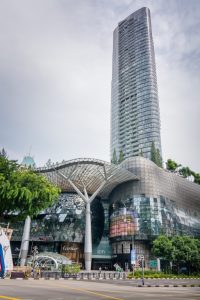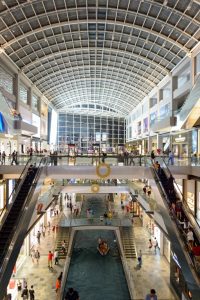These days, American retailers flying to Asia to check out hot new retail opportunities might not have to leave the airport. Some of the most exciting developments are occurring in big, new, ultra-modern terminals.
In Singapore, the independent city-state at the tip of the Malaysian Peninsula, a new airport terminal at Changi Airport – appropriately called “Jewel” – is being built.
It’s an astounding steel and glass biosphere containing lush gardens, five above-ground stories of shopping and dining, enormous gardens and a giant waterfall, along with playgrounds, hiking trails and a luxury hotel. There's also a five-story below-ground parking garage.
Changi Airport Group partnered on the project with CapitaLand Mall Asia (Singapore), one of the continent’s largest mall developers.
If that’s the new bar for American brands considering Asian expansion, it’s not limited to Singapore. South Korea’s Seoul Incheon Intl. Airport has a golf course, spa, private sleeping rooms, an ice-skating rink, casino, indoor gardens and even a Cultural Museum of Korea. Its duty-free shopping mall is regularly rated among the world’s best.
Abu Dhabi, United Arab Emirates, is building a new $5.2 billion Midfield Terminal with a new high-end luxury shopping component, slated for completion by the end of the year. There’s similar development in Dubai, U.A.E. But the lure for travelers is not limited to just the airports, either.
Advertisement
It’s all part of a new way U.S. retailers must strategize for the Asian market, says Dave Scurlock, vp at the Seattle office of CallisonRTKL (Baltimore). “When we consider design options for our clients, an airport presence can become as much a part of the overall design thrust as the high street store, a mall store, a kiosk or a shop-in-shop concept,” he says.
To do that, American brands are learning that they have to do more than just open a store – they must understand the local cultures. According to Bevan Bloemendaal, vp, global environments and creative services, Timberland (Stratham, N.H.), that means truly understanding what “experiential retailing” can be.
“In Asia,” he says, “they take the experiential notion to a completely different level. You see clothing stores with a coffee shop or bakery or floral store component inside. Most retailers offer water or even beer when shoppers walk in.”
Why? Partly it’s the Asian culture of service, Bloemendaal says, “and partly it’s to ensure that they increase every shopper’s dwell time. But to do that, they seek to be part of the consumer’s lifestyle, not just a purveyor of products.”
Timberland has developed an entirely new store design strategy for its aggressive retail rollout in China and South Korea, based on what Bloemendaal calls a “social hub” approach to the storefront windows.
“We use the windows as an opportunity for indoor theater,” he says. “We might have a Timberland employee giving a waterproofing demonstration, throwing water on a leather jacket, or a tattoo artist tattooing leather boots. People gravitating to the kinetic energy are more likely to come inside and browse, ask questions or just sip some Timberland-branded water.”
Advertisement
But the “theater” has to be relevant to the shoppers’ lives and tie into the brand. Bloemendaal says that he, like a lot of today’s store designers, has been influenced by Apple. “Our thought has been, how does our brand integrate into consumers’ lives, like the Genius Bar inside Apple stores? If you buy something from us, we provide as much information and expert advice and technology as you think you need. Rather than just selling you a pair of boots or a jacket, we want to help you know about the merchandise and be able to take care of it.”
Beyond stores, Timberland also strives to connect to the community at large. For the past 15 years, the company – known in the U.S. for its commitment to environmental responsibility – has been planting trees in China’s Horqin Desert, an attempt to convert an area blighted by sandstorms into more productive and sustainable grasslands. Every year, Timberland volunteers trek to the desert in China’s Inner Mongolia to plant trees – two million within the past 15 years.
Sometimes, Bloemendaal says, knowing and becoming a part of a resident culture can go beyond tactics like offering a bottle of water to increase overall dwell time and experience.
Such is the vast challenge retailers face to remain viable and thrive in Asia.
This feature appeared as part of an asia a go go supplement in VMSD's August issue. To learn more about asia a go go or the trip VMSD took to Singapore and Dubai, U.A.E., this past May, click here.


 Photo Gallery3 days ago
Photo Gallery3 days ago
 Headlines1 week ago
Headlines1 week ago
 Sector Spotlight2 weeks ago
Sector Spotlight2 weeks ago
 Headlines1 week ago
Headlines1 week ago
 Headlines4 days ago
Headlines4 days ago
 Headlines2 weeks ago
Headlines2 weeks ago
 Designer Dozen1 week ago
Designer Dozen1 week ago
 Headlines2 days ago
Headlines2 days ago

















